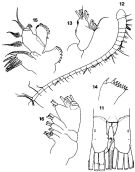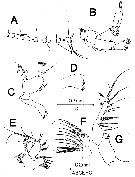|
|
 |
Fiche d'espèce de Copépode |
|
|
Calanoida ( Ordre ) |
|
|
|
Spinocalanoidea ( Superfamille ) |
|
|
|
Spinocalanidae ( Famille ) |
|
|
|
Isaacsicalanus ( Genre ) |
|
|
| |
Isaacsicalanus paucisetus Fleminger, 1983 (F) | |
| | | | | | | Ref.: | | | Fleminger, 1983 (p.607, Descr.F, figs.F); Bradford-Grieve, 1994 (p.98, Déf.); Schulz, 1989 (p.187, figs.F) |  issued from : K. Schulz in Mitt. hamb. zool. Mus. Inst., 1989, 86. [p.201, Figs.11-16]. Female (from off W Mexico): 11, caudal rami (dorsal); 12, A1; 13, A2 (endopodal segment 2); 14, Md (citting edge); 15, Mx1; 16, Mx2. Nota: Caudal rami with inner margins of left and right side slightly asymmetrical resulting from differing position of inner seta, left inner seta located on ventral surface and projecting ventrally, inner seta of right ramus located on dorsal surface and directed dorsally; moreover, right inner seta inserted more distally than left inner seta (this character exactly as found in Teneriforma. Endopodal segment 2 of A2 with a total of 15 setae (correctly given in Fig.2B contrary to Tables 1 and 2 of Fleminger, 1983)
|
 Issued from : A. Fleminger in Proc. Biol. Soc. Wash., 1983, 96 (4). [p.607, Fig.1]. Female (from 20°49.05'N, 109°06.40'W): A-B, habitus (dorsal and lateral, respectively); C, forhead and rostrum (ventral); D, rostrum (anterior); E-F, genital segment (ventral and lateral, respectively); G, caudal rami (dorsal). Nota: Cephalosome and pediger 1 separated, 4th and 5th pedigers incompletely separated, remnant of line of articulation appearing on dorsal side. - Rostrum in lateral view short knob-like; in frontal and ventral views a short simple lobate process. - Prosome : Urosome (caudal ramus included) length ratio: range 2.03 to 2.19:1, median 2.15:1 (n= 10). - Thoracic 5 distal end produced and terminating in a sharp point. - A1 short, extended posteriorly not reaching beyond thoracic segment 5. - Caudal ramus about twice as long as wide, bearing 4 terminal setae and 1 short medial seta at about midlength of ramus. - Genital segment with relatively large seminal receptacles curving anteriorly and swollen distally.
|
 Issued from : A. Fleminger in Proc. Biol. Soc. Wash., 1983, 96 (4). [p.608, Fig.2]. Female: A, right A1 segments 19 to 25 (dorsal); B, right A2 (posterior); C, right Md; D, right Md gnathobase (posterior); E, right Mx1 (posterior); F, right Mx2 (anterior); G, left Mxp (anterior). Nota: A1 23-segmented, segments 8 and 9 and 24 and 25 fused. - A2 with exopod about 1.3 times longer than endopod. Exopod with total of 9 inner setae; exopodal segment 1 lacking seta, exopodal segment 2 with 1 inner seta, remnant of apical segment (8th) with 3 inner setae, distinctly separate from preceding segment, exopodal segment 7, by visible remnant of intersegmental suture; exopodal segment 7 with 1 inner seta. - Md palp with setation similar to that in Teneriforma and Mimocalanus; laft and right gnathobase similar, with 8 major teeth of roughly equal size, a small intercalary tooth between the 2nd and 3rd and the 3rd and 4th major teeth and a slender, short inner seta. Ventral most tooth slender, spiniform, set off others by deeply cut angular notch; remaining teeth distaly bifid; 3 proximalmost teeth bordered by minute denticles. - Mx1 with proximal portion of endopod totally fused to basipod and bearing 4 inner setae; these parts also fused in Teneriforma but combination bearing 10 setae; inner lobe 2 with 1 seta, inner lobe 3 much smaller and lacking seta. - Mxpn with basipod bearing 2 inner setae; inner seta on distalmost segments with minute setules; endopodal segments 2 and 3 with 2 inner setae, endopodal segment 4 with 3 inner setae
|
 Issued from : A. Fleminger in Proc. Biol. Soc. Wash., 1983, 96 (4). [p.609, Fig.3]. Female: A, right P1 (anterior); B, right P2 (posterior); C, right P3 (posterior); D, right P4 (posterior). Nota: P1 with inner seta strongly curved on the basis (as in Monacilla, this seta straight in Teneriforma); lateral shoulder of endopod located at about midlength of segment, strongly produced anterodistad in knob-like process with apex bearing numerous spinules; endopod bearing 5 inner setae (as in Monacilla); both exopodal segments 1 and 2 lacking outer setae (as in Teneriforma described by Farran, 1936, but Grice & Hulsemann, 1965 show exopodal segment 2 with 1 outer seta).
| | | | | Ref. compl.: | | | Smith, 1985 (p.102); Suarez-Morales & Gasca, 1998 a (p.111); Bradford-Grieve, 2004 (p.285) | | | | NZ: | 2 | | |
|
Carte de distribution de Isaacsicalanus paucisetus par zones géographiques
|
| | | | Loc: | | | E Pacif. , off S Baja California, Gulf of California | | | | N: | 3 | | | | Lg.: | | | (541) F: 2,56-2,44; {F: 2,44-2,56} | | | | Rem.: | hyperbenthique, 2600m (source hydrothermale)
Voir aussi les remarques en anglais | | | Dernière mise à jour : 13/05/2016 | |
|
|
 Toute utilisation de ce site pour une publication sera mentionnée avec la référence suivante : Toute utilisation de ce site pour une publication sera mentionnée avec la référence suivante :
Razouls C., Desreumaux N., Kouwenberg J. et de Bovée F., 2005-2025. - Biodiversité des Copépodes planctoniques marins (morphologie, répartition géographique et données biologiques). Sorbonne Université, CNRS. Disponible sur http://copepodes.obs-banyuls.fr [Accédé le 11 juillet 2025] © copyright 2005-2025 Sorbonne Université, CNRS
|
|
 |
 |







